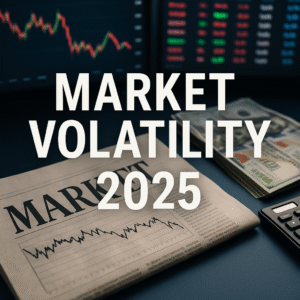In 2025, the tension between former President Donald Trump and the Federal Reserve has returned to the spotlight.
With Trump openly criticizing the Fed’s policies and calling for lower interest rates, investors and economists are closely watching how this political pressure could shape monetary decisions. His public remarks, policy hints, and possible influence on future Fed leadership have stirred fresh debate across Wall Street, Washington, and global markets.
Why this question matters for the U.S. economy and global markets
The relationship between the White House and the Federal Reserve plays a major role in determining economic stability. Any clash or policy shift can impact inflation, the U.S. dollar, and investor confidence worldwide. As America faces slowing growth, rising debt, and shifting trade dynamics, the Trump–Fed relationship could influence everything from stock and bond prices to global capital flows — and even the future direction of Bitcoin and gold as alternative assets.
What the Federal Reserve Does
Simple explanation of how the Fed works
The Federal Reserve, or “the Fed,” is the central bank of the United States. Its main job is to keep the economy stable by controlling the money supply and managing interest rates. When the Fed raises rates, borrowing becomes more expensive, which can slow spending and inflation. When it cuts rates, loans get cheaper, encouraging people and businesses to spend and invest, which boosts growth.
Why the Fed is supposed to stay independent from politics
The Fed is designed to operate independently of political influence. This allows it to make decisions based on economic data, not political pressure. Independence helps maintain trust in the U.S. dollar and keeps global investors confident. Even if political leaders want quick results, the Fed can focus on long-term economic stability.
How its decisions affect interest rates, inflation, and jobs
Every Fed decision affects the economy. Higher rates reduce spending and help control inflation but can slow job growth. Lower rates encourage borrowing, spending, and hiring, but may increase inflation. The Fed constantly balances these goals: keeping prices stable, maximizing employment, and supporting sustainable economic growth. Its actions influence mortgages, credit cards, stock markets, and even global trade.
What Trump Wants
Trump’s recent statements about the Fed and Jerome Powell
In 2025, Donald Trump has openly criticized the Federal Reserve and its chairman, Jerome Powell. He claims that high interest rates are slowing economic growth and hurting American families. Trump frequently uses public statements and social media to call for faster rate cuts, arguing that the Fed should act more aggressively to stimulate the economy.
His push to get more control over rate decisions
Trump has also suggested giving the White House more influence over the Fed’s decisions. This includes potentially shaping interest rate policy or replacing Fed leaders who do not align with his views. His plan is aimed at making monetary policy more responsive to political goals, especially before elections.
Why many experts and investors are worried about this plan
Economists and market analysts are concerned because reducing Fed independence could undermine trust in U.S. financial policy. Political influence over interest rates may lead to inflation, market instability, and weaker confidence among global investors. If markets perceive the Fed is not making decisions based on data, both U.S. stocks and global markets could face volatility, and safe-haven assets like gold and Bitcoin might see sudden shifts.
What Could Happen If Trump Controls the Fed
How markets might react if the Fed loses independence
If the Fed comes under political influence, markets could become highly volatile. Investors generally trust the Fed to make decisions based on data, not politics. Losing this independence may trigger uncertainty, causing rapid sell-offs in risk assets and sudden shifts in investment behavior.
Possible effects on stocks, gold, Bitcoin, and the dollar
Stocks could see short-term gains if rate cuts are implemented quickly, but long-term stability may suffer. Gold might rise as investors seek a safe haven against political-driven instability. Bitcoin and other cryptocurrencies could also benefit from increased interest as alternative assets. Meanwhile, the U.S. dollar could weaken if markets fear inflation or poor policy decisions.
What it could mean for inflation and the U.S. economy
Political control over the Fed could push interest rates too low for too long, increasing inflation. Higher prices could erode consumer purchasing power and create economic imbalances. While short-term growth might appear positive, the long-term risk includes runaway inflation, weaker confidence in U.S. financial policy, and greater global market instability.
How the Market Is Reacting Now
What investors are already doing ahead of 2025 policy changes
Investors are becoming more cautious as the possibility of political interference at the Federal Reserve grows. For example, some are reducing exposure to long‑duration bonds and upping allocations in assets seen as hedges, like gold and other safe havens. Also, many hedge funds and global traders are trimming risk ahead of major policy shifts, such as potential Fed leadership changes or rate policy signaling.
One recent snapshot: the 10‑year U.S. Treasury yield edged down to around 4.15% as of September, indicating markets are factoring in slower growth and a likely easing cycle. Ofi Invest AM+1
How Wall Street, banks, and global traders see Trump’s pressure
There is rising concern on Wall Street that pressure from Donald Trump on the Fed could shake confidence in U.S. monetary policy. Financial institutions warn that doing so might “de‑anchor” inflation expectations and force bond investors to demand higher yields. Reuters+1
In fact, markets are watching legal and institutional boundaries: when Trump’s threats toward Fed Chair Jerome Powell resurfaced, the bond market “stood on edge”, and yields jumped. Yahoo Finance
Real data: bond yields, stock trends, and investor fear indexes
-
U.S. Treasury yields: After some optimism around easing, recent Fed signals dampened hopes of immediate rate cuts — for example, euro‑zone bond yields again rose after a Fed meeting because markets realised cuts might be delayed. The Economic Times+1
-
Stock markets: The S&P 500 and other major indices have shown signs of strain under uncertainty. For instance, global warnings have grown about a sudden sharp correction in U.S. stocks due to concentration risk and monetary policy uncertainty. The Guardian
-
Investor fear/volatility: Fear indexes are climbing as policy risks rise. When the Fed gave mixed signals about cuts and inflation, the CBOE Volatility Index (VIX) surged nearly 74% in one episode. MarketWatch
What It Means for You (Investors’ View)
How to stay safe if markets turn volatile
With uncertainty around Trump’s influence on the Fed, markets can swing quickly. Investors should avoid overexposure to high-risk assets and keep some portion of their portfolio in stable or liquid investments. Using stop-loss orders, diversifying across asset classes, and keeping cash reserves ready can help manage sudden drops. Staying informed about Fed announcements and global market news is also essential.
Where Gold, Bitcoin, and U.S. bonds fit in 2025 portfolios
Gold remains a reliable safe haven during political and economic uncertainty. Bitcoin can serve as a modern hedge, potentially offering high returns when liquidity increases, but it comes with higher volatility. U.S. Treasury bonds are traditionally lower-risk, providing steady income, but their prices may fluctuate if political pressure affects interest rate policy. A balanced portfolio could include all three: Gold for stability, Bitcoin for growth potential, and bonds for income and risk management.
Tips for short-term and long-term strategies
For the short term, monitor market reactions around Fed announcements and political news. Consider adjusting allocations dynamically to protect against volatility. For the long term, focus on diversification, fundamental strength of assets, and maintaining a mix of safe havens and growth opportunities. Keeping a clear plan and avoiding panic-driven trades can help investors navigate a policy-sensitive market throughout 2025.
Global and Regional Effects
How this situation can impact other countries
Political pressure on the Federal Reserve does not just affect the U.S. economy — it has ripple effects worldwide. If Fed independence weakens, global investors may lose confidence, triggering volatility in stock markets, commodity prices, and foreign exchange rates. Emerging markets, in particular, could see capital outflows as investors seek safer assets like the U.S. dollar, gold, or stable cryptocurrencies.
Why South Asia and Pakistan could feel indirect effects
South Asian markets, including Pakistan, are sensitive to global liquidity and investor sentiment. A weaker dollar or rising inflation in the U.S. can affect exports, imports, and foreign investment flows. Local equities and crypto markets may experience sudden price swings due to shifting capital from international investors reacting to U.S. policy risks.
Currency and trade risks if the U.S. policy becomes unstable
If the Fed’s decisions are perceived as politically influenced, the U.S. dollar could fluctuate sharply. This creates currency risk for countries reliant on trade with the U.S. or holding dollar-denominated debt. Import costs may rise, inflation could increase, and trade balances may worsen. Investors and businesses in South Asia need to monitor exchange rates, commodity prices, and global market signals closely to mitigate potential losses.
Conclusion
Simple summary: can Trump really control the Fed?
While Trump can voice opinions and pressure the Fed publicly, the Federal Reserve is designed to operate independently. Legal safeguards and institutional rules make it difficult for any president to directly control interest rate decisions. However, repeated political pressure can influence market sentiment and investor confidence, even if it does not change formal policy.
Final thoughts: what investors should watch next
Investors should keep a close eye on Fed statements, interest rate forecasts, and political developments. Key indicators include bond yields, stock market trends, and safe-haven assets like gold and Bitcoin. Staying diversified, monitoring liquidity flows, and having contingency plans for volatility will be essential for navigating the uncertain 2025 landscape.
5 FAQs — Trump vs. the Federal Reserve (2025)
1. Can Trump directly control the Federal Reserve?
No. The Fed is legally independent, and presidents cannot force interest rate decisions. Political pressure may influence sentiment, but policy is based on economic data.
2. Why is Trump criticizing the Fed in 2025?
Trump believes high interest rates are slowing economic growth and hurting American families. He is calling for faster rate cuts and more responsive monetary policy.
3. How could markets react if the Fed loses independence?
Markets could become highly volatile. Stocks might rise short-term on rate cuts, while safe-haven assets like gold and Bitcoin could surge. Long-term stability and investor confidence could suffer.
4. What should investors watch most closely?
Key indicators include Fed statements, interest rate forecasts, bond yields, stock trends, and safe-haven flows. Monitoring global liquidity and ETF activity is also important.
5. How can investors protect themselves in 2025?
Diversify portfolios across Gold, Bitcoin, bonds, and select altcoins. Avoid excessive leverage, keep some cash or stablecoins for flexibility, and follow Fed announcements and political developments closely.







